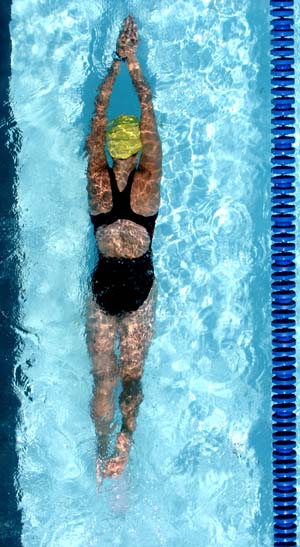
The other day I received an email from an athlete mentioning that when he trains there are always people flying by and it is very hard to let them go because he has to keep his heart rate in check. Then I received another that mentioned that he always feels well in the pool and almost like a fish until someone else jumps in the lane and starts going faster. Isn’t it funny how that works? Just when we think we are doing great here comes someone to ruin the day.
But the reality is that nothing has changed it is only our minds playing games. Weather you are the fastest in the pool or the slowest in the pool it really does not matter. As long as you are doing well relative to yourself you are doing fine.
So just a few hours after I replied to the email I decided to go swim with my masters team in Boulder. I arrived a little late and as I am getting ready to get in I notice that there are two people in there that I have no idea who they were and they look rather fast. One tall guy is leading the lane and a rather slender girl is second with some pink outfit. Next in the lane was a friend and I was jumping in behind. Hmmm? Should I be getting in this lane? Well I jumped in and after a few reps the girl in the pink outfit says to me. Do you swim in San Diego? No, I said. Wrong guy she replies and takes off. Well I was happy to be in the back of the lane. These guys were flying and I was glad our longest swim was only a 200 or so because I would have been lapped. My mind was wondering who this people were as you can imagine. Turns out the guy leading is a former College swimmer and the girl holds about 40 FINA World masters records. They were visiting our masters team and wanted to try out our practice. They sure looked the part. But this goes to show you. It is all relative. Many people think I am a fast swimmer but it is all relative to the pond we swim in.
So since we are speaking about swimming I am going to write about something that I had to think and research for our forum. That is our stroke rate. We tell people that we should try to do about 90 RPM on the bike. But what about the stroke rate when we swim. How many strokes per minute should we be doing? This was an interesting question from one of our athletes and this is posted on the forum but here it is too; I have been swimming for nearly my entire life and I never encountered the concept of how fast to stroke or “stroke rate” as such. The main reason was because the tendency is for swimmers to stroke as fast as possible and ignores everything else. Therefore most coaches concentrate on distance per stroke or as others call it “strokes per length” of a pool. But the truth is that both numbers are important. I have helped many athletes that have fairly decent stroke technique and good distance per stroke but they always look like they are just cruising and enjoying themselves a little too much. It would seem that if these people tried to increase their stroke rate they will do a little better. We just have to not sacrifice too much distance per stroke and maintain technique. The goal is to have the least number of strokes per length of a pool and the highest stroke rate.
It would help if we knew our own stroke rate but this is not easy to do. One would like to use the similar method as in running or cycling therefore counting strokes per minute. However this is hard to do as you will most likely encounter a pool wall before a minute is up thus interrupting your tempo. One possibility is to only do it for 15 seconds and multiply the number by 4. I will also suggest you count both arms so that you deal with bigger numbers. Finally do not do this for a fast 25. Have someone count it for you in the middle of a 500. That stroke rate would be more significant and valuable for use as a triathlete that is training for distance and not the 50 sprint.
So the question was about the ideal number. The numbers for elite swimmers are very different that the ones for your average triathlete. Plus you can not talk about stroke rate without considering distance per stroke. My recommendation is to combine both your distance per stroke and your stroke rate so that both numbers improve over time. In the off season you can concentrate on distance per stroke. Count the strokes that it takes you to cross the pool and try to get that number as low as possible while maintaining good form. Then as your races get closer and closer you try to improve your stroke rate while keeping the form and distance per stroke as high as possible.. You can even use the long swims as distance per stroke days and your speed days as stroke rate days.
If you can improve both numbers you will undoubtedly start swimming faster and be able to move to a faster pond.